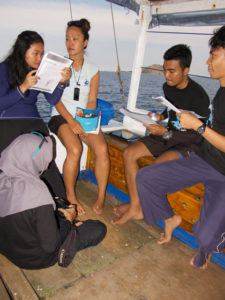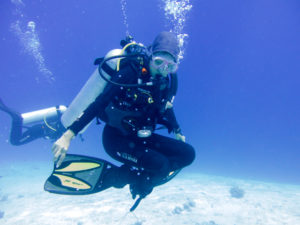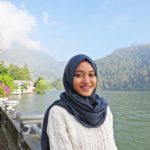Today was had our first first dive in this Internship! We started our PADI Advanced Open Water training by refreshing our basic diving skills. It was an early start, and by 7 o’clock we had already arrived at Dive Komodo to meet our dive instructors Ms. Wai-Lei and Mr. Stuart. We also met Mr. Kamal, a ranger from the Komodo National Park Authority who is joining us for this dive training.
Our first dive was at a dive site called Sebayur Kecil. We descended to about 16 m depth to proactive our Peak Performance Buoyancy. Good buoyancy control takes a lot of practice! As we descended, we inflated our BCDs to maintain neutral buoyancy, and then we practiced how to clear our regulators, regulator recovery and mask clearing. We had to do all of this whilst hovering and neutrally buoyant, so we had to learn how to breath and kick efficiently. By maintaining good buoyancy control and streamlining our equipment, Wai told us that we can save air and energy. This is also very important to avoid damaging the environment by kicking corals, or disturbing sand and silt which can cause bad visibility. I think these skills will also be important when we start our manta surveys, and will help us to capture good manta ID photos!
Next we went to Sabolon Kecil, where we practiced deep diving in 26 m depth. We performed exercises at depth to see how colours change, and compared our depth gauges and dive computers. After lunch we went to Sabolon Besar for our third dive where we learned underwater navigation. We began with an easy exercise – reciprocal bearings which means following a compass in a straight line out and back. After that we had to use our compass to navigate a square, by making 90 degree turns and carefully counting our fin kicks. We had to pay attention to our turn using heli-kicks, our kick cycle to estimate the distance, and make sure that our depth is consistent while focusing on the compass. So much to think about! We also tried navigating using natural references such as corals, rocks and other underwater features. Our task was to navigate back to our start location, and we had to be very observant during the dive to notice landmarks for navigation.
We saw many marine organisms today, including garden eels, an eagle ray, lionfish, giant clams, a zebra moray eel, crocodilefish, scorpionfish, spearing mantis shrimp, and so much more. The water was so clear that we could see 20 m or more underwater. It was so beautiful, amazing, and yes we fell in love with the underwater world!




